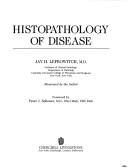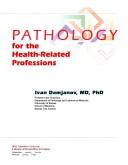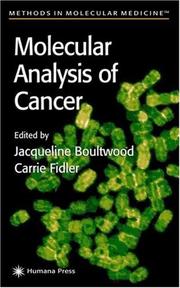| Listing 1 - 10 of 1002 | << page >> |
Sort by
|
Book
ISBN: 0397447647 9780397447640 Year: 1995 Publisher: London: Mosby,
Abstract | Keywords | Export | Availability | Bookmark
 Loading...
Loading...Choose an application
- Reference Manager
- EndNote
- RefWorks (Direct export to RefWorks)
Pathology --- Disease (Pathology) --- Pathologie

ISBN: 0443085668 Year: 1989 Publisher: Edinburgh : Churchill Livingstone,
Abstract | Keywords | Export | Availability | Bookmark
 Loading...
Loading...Choose an application
- Reference Manager
- EndNote
- RefWorks (Direct export to RefWorks)

ISBN: 0721664695 9780721664699 Year: 1996 Publisher: Philadelphia (Pa.) Saunders College Publishing
Abstract | Keywords | Export | Availability | Bookmark
 Loading...
Loading...Choose an application
- Reference Manager
- EndNote
- RefWorks (Direct export to RefWorks)
Pathology --- pathologie --- Disease (Pathology) --- Medical sciences --- Diseases --- Medicine --- Medicine, Preventive
Book
ISBN: 9535164457 9533073837 Year: 2011 Publisher: IntechOpen
Abstract | Keywords | Export | Availability | Bookmark
 Loading...
Loading...Choose an application
- Reference Manager
- EndNote
- RefWorks (Direct export to RefWorks)
Electroretinography (ERG) is a non-invasive electrophysiological method which provides objective information about the function of the retina. Advanced ERG allows to assay the different types of retinal receptors and neurons in human and animal models. This book presents contributions on the recent state of the ERG. The book is divided into three parts. The first, methodological part, reviews standard methods and normatives of human ERG, reports about the advanced spatial, temporal and spectral methods of stimulation in human ERG, and deals with the analysis of the multifocal ERG signal. The second part deals with the ERG in different diseases of the human visual system and in diabetes. The third part presents the ERG in the standard animal models of human retinal disease: mouse, rat, macaque and fruitfly.
Pathology. --- Disease (Pathology) --- Medical sciences --- Diseases --- Medicine --- Medicine, Preventive --- Pathology
Book
ISBN: 9535108662 953517049X Year: 2012 Publisher: IntechOpen
Abstract | Keywords | Export | Availability | Bookmark
 Loading...
Loading...Choose an application
- Reference Manager
- EndNote
- RefWorks (Direct export to RefWorks)
This edition aims to present some relevant topics in the histopathology area that may be of interest for medical doctors and for other professionals interested in pathology. Histopathology applies basic knowledge obtained from biologic and anatomic science to make diagnosis, to determine the severity and progress of a condition and to evaluate the possible response to certain therapies. Thus, it is not surprising that this discipline constantly expands with progresses produced in biology. In addition, novel technologies that have been recently incorporated, and the adoption of the histopathological methods by different areas, contribute to enlarge the fields that may apply the histopathological methodology. The papers selected for this book comprise a cross-section of topics that reflect the variety of perspectives that histopathology contemplates. Selected representative reviews of topics that are considered relevant or introduce novel concepts are included in this book.
Pathology. --- Disease (Pathology) --- Medical sciences --- Diseases --- Medicine --- Medicine, Preventive --- Histopathology
Book
ISBN: 0713144580 Year: 1987 Publisher: London Victoria Baltimore Arnold
Abstract | Keywords | Export | Availability | Bookmark
 Loading...
Loading...Choose an application
- Reference Manager
- EndNote
- RefWorks (Direct export to RefWorks)
Disease (Pathology) --- Pathologie --- Pathology --- Pathological anatomy and histology
Book
ISBN: 3319769804 3319769790 Year: 2019 Publisher: Cham : Springer International Publishing : Imprint: Springer,
Abstract | Keywords | Export | Availability | Bookmark
 Loading...
Loading...Choose an application
- Reference Manager
- EndNote
- RefWorks (Direct export to RefWorks)
This updated and expanded second edition covers all of the diagnostic areas where FNAC is used today. Each chapter follows a similar, practical format: diagnostic criteria with an emphasis of differential diagnoses; diagnostic problems and pitfalls; and relevant findings of ancillary methods. Authoritative discussions will reflect accepted international viewpoints. The interaction of the cytologist or cytopathologist with other specialists (radiologists, oncologists and surgeons) is emphasized and illustrated throughout. With contributions from experts in the field internationally and many new colour images Atlas of Fine Needle Aspiration Cytology, Second Edition provides a comprehensive and up-to-date guide to FNAC for pathologists, cytopathologists, radiologists, oncologists, surgeons and others involved in the diagnosis and treatment of patients with suspicious mass lesions.
Pathology. --- Disease (Pathology) --- Medical sciences --- Diseases --- Medicine --- Medicine, Preventive
Book
ISBN: 3030179311 3030179303 Year: 2019 Publisher: Cham : Springer International Publishing : Imprint: Springer,
Abstract | Keywords | Export | Availability | Bookmark
 Loading...
Loading...Choose an application
- Reference Manager
- EndNote
- RefWorks (Direct export to RefWorks)
This book presents the broad morphologic spectrum of the most commonly encountered diseases of the uterine corpus and cervix in an easy-to-use, practically relevant format. It emphasizes the morphologic and immunophenotypic features of disease entities, with some additional coverage of normal histology, but is not meant to be a comprehensive treatise on all aspects of uterine surgical pathology. The book is divided into 12 chapters that reflect broad clinicopathologic categorizations and presumed lines of differentiation, with 6 chapters each on uterine corpus and uterine cervix diseases. Short clinicopathologic summary descriptions are presented as figure legends for each entity, emphasizing the most salient information. The image selection focuses on classical appearances as well as less common morphologic variations. Selected images that depict classical immunophenotypes are also presented and discussed. The Atlas of Uterine Pathology serves as a very useful resource to practitioners and trainees of uterine surgical pathology, as well as to clinicians and investigators interested in the morphology of uterine diseases.
Pathology. --- Disease (Pathology) --- Medical sciences --- Diseases --- Medicine --- Medicine, Preventive
Book
ISBN: 3030268837 3030268829 Year: 2020 Publisher: Cham : Springer International Publishing : Imprint: Springer,
Abstract | Keywords | Export | Availability | Bookmark
 Loading...
Loading...Choose an application
- Reference Manager
- EndNote
- RefWorks (Direct export to RefWorks)
This text describes a system of reporting breast fine needle aspiration biopsy that uses five clearly defined categories, each described by a specific term and each with a specific risk of malignancy. The five categories are insufficient/inadequate, benign, atypical, suspicious of malignancy and malignant. Each category has a risk of malignancy and is linked to management recommendations, which include several options because it is recognized that diagnostic infrastructure, such as the availability of core needle biopsy and ultrasound guidance, vary between developed and low and middle income countries. This text includes key diagnostic cytological criteria for each of the many lesions and tumors found in the breast. The cytopathology of specific lesions is illustrated with high quality photomicrographs with clear figure descriptions. Chapters also discuss current and potential future ancillary tests, liquid based cytology, nipple cytology and management. An additional chapter provides an overview of an approach to the diagnosis of direct smears of breast fine needle aspiration biopsies. The International Academy of Cytology Yokohama System for Reporting Breast Fine Needle Aspiration Biopsy Cytopathology provides a clear logical approach to the diagnosis and categorization of breast lesions by FNAB cytology, and aims to facilitate communication with breast clinicians, further research into breast cytopathology and related molecular pathology, and improve patient care. .
Pathology. --- Disease (Pathology) --- Medical sciences --- Diseases --- Medicine --- Medicine, Preventive

ISBN: 1592591353 9786610821020 1280821027 0585438919 0896036227 Year: 2002 Publisher: Totowa, NJ : Humana Press : Imprint: Humana,
Abstract | Keywords | Export | Availability | Bookmark
 Loading...
Loading...Choose an application
- Reference Manager
- EndNote
- RefWorks (Direct export to RefWorks)
Molecular biotechnology has in recent years produced significant advances in finding tumor markers useful in diagnosis and in the assessment of disease progression and prognosis. In Molecular Analysis of Cancer, leading researchers in the field describe in step-by-step detail their best state-of-the-art molecular techniques for elucidating the biochemical processes associated with human cancer. Among the techniques presented for identifying chromosomal rearrangements are fluorescent in situ hybridization (FISH), spectral karyotyping (SKY), comparative genomic hybridization (CGH), microsatellite analysis, PCR and RT-PCR, and DNA fingerprinting. Additional methods include SSCP, DGGE, the nonisotopic RNase cleavage assay, and the protein truncation assay and DNA sequencing for identifying mutations. Techniques for the analysis of gene expression include microarray technology and differential display. All these techniques are of great value for identifying genes that are central to cancer development and progression. Comprehensive and state-of-the-art, Molecular Analysis of Cancer not only offers today's researcher a deeper understanding of cancer's molecular pathogenesis, but also provides a detailed examination of each of the major methodologies needed to detect and analyze its associated genetic abnormalities.
Pathology. --- Disease (Pathology) --- Medical sciences --- Diseases --- Medicine --- Medicine, Preventive
| Listing 1 - 10 of 1002 | << page >> |
Sort by
|

 Search
Search Feedback
Feedback About UniCat
About UniCat  Help
Help News
News